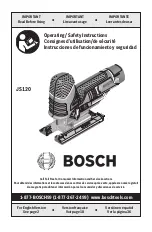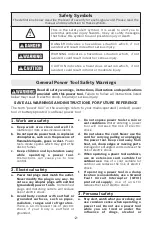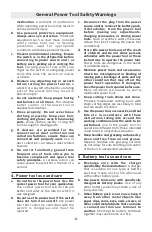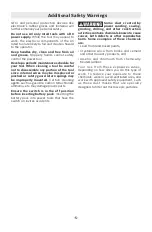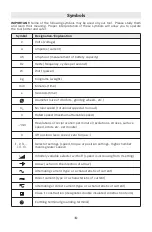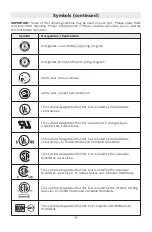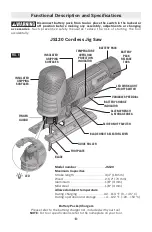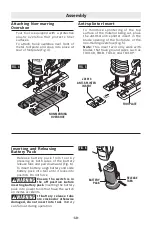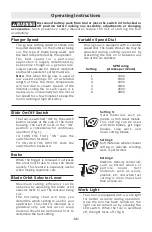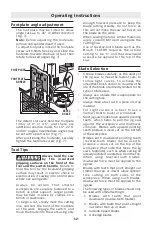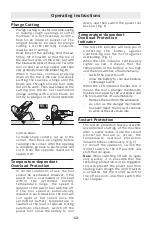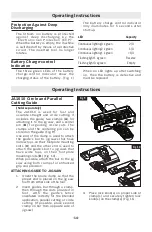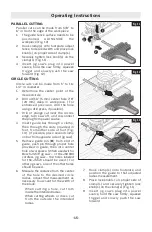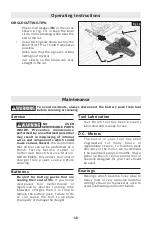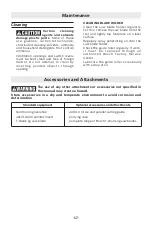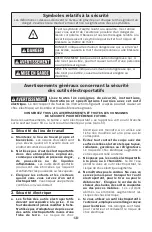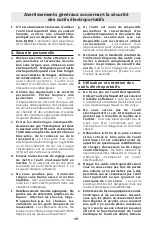
-4-
General Power Tool Safety Warnings
d.
Under abusive conditions, liquid may be
ejected from the battery, avoid contact.
If contact accidentally occurs, flush with
water.
If
liquid
contacts
eyes,
additionally seek medical help.
Liquid
ejected from the battery may cause
irritation or burns.
e.
Do not use a battery pack or tool that is
damaged or modified.
Damaged or
modified
batteries
may
exhibit
unpredictable behaviour resulting in fire,
explosion or risk of injury.
f.
Do not expose a battery pack or tool to
fire or excessive temperature.
Exposure
to fire or temperature above 265 °F may
cause explosion.
g.
Follow all charging instructions and do
not charge the battery pack or tool
outside the temperature range specified
in the instructions.
Charging improperly
or at temperatures outside the specified
range may damage the battery and
increase the risk of fire.
6. Service
a.
Have your power tool serviced by a
qualified repair person using only
identical replacement parts.
This will
ensure that the safety of the power tool is
maintained.
b.
Never service damaged battery packs.
Service of battery packs should only be
performed by the manufacturer or
authorized service providers.
Safety Rules for Jig Saws
a.
Hold the power tool by insulated
gripping surfaces, when performing an
operation where the cutting accessory
may contact hidden wiring.
Cutting
accessory contacting a "live" wire may
make exposed metal parts of the power
tool "live" and could give the operator an
electric shock.
b.
Use clamps or another practical way to
secure and support the workpiece to a
stable platform.
Holding the workpiece
by hand or against your body leaves it
unstable and may lead to loss of control.
c.
D o n o t d r i l l , f a s t e n o r b r e a k i n t o
existing walls or other blind areas
where electrical wiring may exist.
If
this situation is unavoidable, disconnect
all fuses or circuit breakers feeding this
worksite.
d.
Disconnect battery pack from tool or
place the switch in the locked or off
position before making any assembly,
adjustments or changing accessories.
Such preventive safety measures reduce
the risk of starting the tool accidentally.
e.
Never leave the trigger locked "ON".
B e f o r e i n s e r t i n g t h e b a t t e r y p a c k ,
check that the trigger lock is "OFF".
Accidental start-ups could cause injury.
f.
Keep hands away from cutting area.
Do not reach under the material being
cut.
The proximity of the blade to your
hand is hidden from your sight.
g.
Keep hands from between the gear
housing and saw blade holder.
The
reciprocating blade holder can pinch
your fingers.
h.
Do not use dull or damaged blades.
Bent blade can break easily or cause
kickback.
i.
Before starting to cut, turn tool "ON"
and allow the blade to come to full
speed.
Tool can chatter or vibrate if
blade speed is too slow at beginning of
cut and possibly kickback.
j.
Secure material before cutting. Never
hold it in your hand or across legs.
Small or thin material may flex or vibrate
with the blade, causing loss of control.
k.
Make certain all adjusting screws and
t h e b l a d e h o l d e r a r e t i g h t b e f o r e
making a cut.
Loose adjusting screws
and holders can cause the tool or blade
to slip and loss of control may result.
l.
When removing the blade from the tool
avoid contact with skin and use proper
protective gloves when grasping the
blade or accessory.
Accessories may
be hot after prolonged use.
Summary of Contents for JS120
Page 54: ... 54 Notes Remarques Notas ...
Page 55: ... 55 Notes Remarques Notas ...

